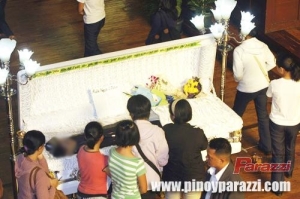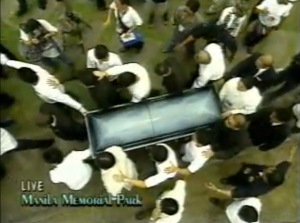(NOTE: This is half of our final paper for Journalism Ethics [ J 192] class under Prof. Yvonne T. Chua in March 2009, Written with Andrew Jonathan Bagaoisan and AM Bernal. I now work for GMA News, while co-writer Anjo is with ABS-CBN News. Read part 1 from his blog here.)
When “stars die”, they reach the headlines. But the media might have a different aim other than paying their last respects in kind through media coverage: to have news content worthy of a large audience share. This often results to sensational ratings-driven news. Yes, the public figures called celebrities deserve the public eye, but up to what extent?
“Any newsman worth his salt knows immediately the big stories of the day. It’s what people are talking about, what interests the viewers, what they need to know and what they would like to know,” said Manalastas.
The question rests on who determines public interest. And when does the aggrieved put a line between intruding and fair coverage?
For Luz Rimban, who now teaches journalism at the Ateneo de Manila University, no ethical issues confront covering celebrities because they fall under the public figure doctrine more often applied to politicians than artists.
“When their deaths are very sudden, untimely, shocking …they become even more legitimate news subjects,” she added.
One news report on their Dec. 8, 2008 episode showed Mrs. Cadaweng being interviewed while in grief. They blurred Marky’s face inside the casket as she requested.
The reports also delved on the grief of the celebrities who visited, most of whom were Marky’s co-stars in his television shows. They also showed the crowd outside the Cielo home in Baguio pushing and shoving each other just for a glimpse of the “stars”.
However, the problem begins when the media “milk a celebrity’s death for publicity value.” In turn, the networks lose ad revenue, like in the case of Rico Yan.
“When you intrude into the grief of others, that’s when it becomes bad taste… A camera doesn’t have to be present all the time. It’s bad enough that they lost loved ones, but to do it in the glare of the camera, it will be difficult for them,” Rimban said.
Such may be the case when two rival showbiz programs once again mugged over an apparent disrespect of privacy.
Even Cielo’s death was not spared from controversies and the enduring network war, specifically their weekend showbiz talk shows, Startalk and The Buzz. According to Philippine Entertainment Portal, the ABS-CBN crew continued to air shots of Marky in the casket, something Cadaweng wished the media not to do. This was said to have stirred the ire of the late actor’s mother in turn.
“Nagtaka naman ako nang nalaman ko na lumabas sa news, nandoon yung mukha niya [Marky], kung saan, paulit-ulit akong nag-e-explain at humihingi ng paumanhin kung bakit ayaw naming pakuhanan ng picture… Bakit ginawa nila yun? Talagang masakit ang loob ko dun,”Cadaweng said in one of Startalk’s interviews.
Startalk issued a statement on their Dec. 13, 2008 episode criticizing their rival station’s violation of the “basic human right to dignity”, something ABS-CBN promptly denied in a reply statement aired on The Buzz. They claimed that they asked permission for coverage from Cadaweng
“It’s everyone’s freedom to know the latest news and it is our responsibility to get them and deliver them to the public,” The Buzz’s statement added.
They said Cadaweng warmly welcomed their crew into their Benguet home and they only sought to do their duties as media persons and colleagues in the entertainment industry. They further claimed that GMA 7 started the issue that did not exist in the first place.
“Probably covering the celebrity is an expression of their own losses and grief over the death of their celebrity,” Rimban said.
The GMA News and Public Affairs Ethics Manual has but a vague provision in covering celebrities’ deaths in Section II, which covers fairness and fair play. The manual also lacks items on how reporters should treat news stories that involve the TV network, its executives, and its talents.
On the issue of privacy, the Ethics Manual indicated that “people’s activities within a non-public place such as their home is considered private and should not be subjected to any form of surveillance unless journalists are sure that public interest is at stake. The rule is to stick to the relevant facts, avoid gossip…Still, reporters and producers must not intrude into private matters concerning these people that have no bearing on public interest, or are of no concern to the public.”
Rimban also noted that the problem may also come from the different methods employed in covering and the different nature of the entertainment press from that of the news and public affairs department. Rimban added the entertainment press is not used to journalistic standards of reporting because they are run by people in show business.
Although the entertainment and “hard” news media may have different objectives, a blurred line between them still exists. Rimban noted that the entertainment press, as exemplified by Startalk and The Buzz, tend to forget the journalistic standards and practice inaccuracy and sensationalism.
“Dapat i-apply sa kanila yung code of ethics ngjournalism profession kasi they’re part of the profession, di ba? (The journalist’s code of ethics should also apply to them because they are also part of the profession)” Rimban said
In 1997, half a decade before Rico Yan died, not just a country, but the world, was held captive by another “untimely” death. This time it was a mix of showbiz, wealth, and royalty. The accident and funeral of Diana, the British Princess of Wales, showed an unrelenting drive in the media to keep the events surrounding her death and after constantly in the public eye.
Despite the sentimentality and outpouring of emotion that followed Diana’s death, the media was quickly criticized for actually causing it. The public drive for news about the royals led paparazzi to pursue the Princess any time. On the other hand, the media attention which followed all the way to her burial was no different as well.
The problem, then, is not a new one. However, changes in how the media differentiates hard news from entertainment news, as well as how they are done should be pursued.
It is important to maintain high ethical standards in entertainment and public affairs news. The entertainment media can also adhere to the journalists’ code of ethics, even if they live by the orders of their superiors. Showbiz news items are better off in the showbiz news section, unless the subject is of utmost public interest. Needless to say, sensationalism should not be practiced.
A clear-cut ethics manual for entertainment journalists can also be created, having the same provisions as the journalist’s code of ethics, but addressing the issues involved in the entertainment industry, like covering a celebrity’s death.
Entertainment news can’t be easily removed. They can, however, be given better journalistic treatment than what is shown on television now. There is a need for showbiz journalists, reporters who don’t tell stories based on hearsay and mostly for the sake of publicity, but report in the name of newsworthiness, public interest, and accuracy.
On Mar. 11, 2009 Magalona’s friends carried his remains to be cremated before sunrise, and his ashes brought to Christ the King for a final mass. People flocked Loyola Memorial Park, even at roadsides and waited for the procession, eager to see the urn that carried what remained of the Master Rapper.
There were no reporters stationed at key areas, no chopper shooting the footage from above, and no hours-long coverage on the music icon’s final journey. What GMA 7 aired during primetime was an almost four-minuter about the funeral of the “Man from Manila”.
____________________________________________
References:
Coronel, S. (ed.). (1999). From Loren to Marimar: Philippine media in the 1990s. Quezon City: Philippine Center for Investigative Journalism
Erece, Dino (2008). “A heartbreaking “StarStruck” reunion at Marky Cielo’s wake”. Philippine Entertainment Portal. Retrieved March 17, 2009 from http://www.pep.ph/news/20157/A-heartbreaking-StarStruck-reunion-at-Marky-Cielos-wake
Flores, M. (producer). (2008, Dec. 8). 24 Oras [television recording]. GMA Network, Inc.
Flores, M. (producer). (2008, Dec. 9). 24 Oras [television recording]. GMA Network, Inc.
Flores, M. (producer). (2008, Dec. 10). 24 Oras [television recording]. GMA Network, Inc.
Flores, M. (producer). (2009, Mar. 6 to 11). 24 Oras [television recording]. GMA Network, Inc. Retrieved March 11, 2009 from http://www.gmanews.tv/video
Garcia, Rose & Elyas Isabelo Salanga (2008). “Network War Extends to the Coverage of Marky Cielo’s wake”. Philippine Entertainment Portal. Retrieved March 17, 2009 from http://www.pep.ph/news/20233/Network-war-extends-to-coverage-of-Marky-Cielo&.
GMA News and Public Affairs. (n.d.). GMA News and Public Affairs Ethics Manual.
Salterio, L. (2002, April 5). A funeral fit for a president for the boy who wanted to be one (edited). Philippine Daily Inquirer. Retrieved on March 9, 2009 from http://www.geocities.com/MIGHTORS4/Ricky/Ry-interment.html
Salterio, L. (2002, Sept. 1). ‘Guilty’ after Rico Yan coverage, ABS-CBN joins tribute to National Artists. Philippine Daily Inquirer. Retrieved on March 24, 2009 from



